

The Ultimate Guide to Creating A Successful Agile Release Plan






In 2025, organizations across industries are more agile than ever: Engineering & R&D teams now account for 48% of agile practitioners, a 16% jump from 2022. Agile’s influence has also spread far beyond software development, with business operations, marketing, and leadership embracing iterative workflows, continuous feedback loops, and measurable outcomes.
But having agile adoption doesn’t automatically mean having a good release plan. A strong Agile Release Plan coordinates priorities, timelines, team capacity, risk mitigation, and stakeholder alignment.
At this stage, the only question running through your mind must be, how can you incorporate the release plan for successful software development? What are the elements to consider for the product roadmap? The answer to all these questions is having a thorough Agile project plan.
Agile release planning is a product management technique that helps you with your software development and agile project plan. It acts as a project roadmap to provide the directions to your product goals and visions.
The release process in agile helps to focus on the roadmap leading to short-term goals. However, repeating the same process will ultimately allow you to achieve your final goal faster. As reported by PMI, lack of clearly defined goals is the most common factor for software failure, and hence, Agile release planning is the most crucial stage of product development.
In this article, we’ll walk through how to build an agile release plan that works, its key components, latest tools, metrics, and best practices.
In 2025, agile release planning must adapt to distributed and remote teams. Effective collaboration relies on digital-first tools, shared visibility, and synchronized workflows, ensuring alignment across geographies while maintaining agility, speed, and continuous stakeholder communication.
Here are a few reasons why agile release planning matters in 2025.
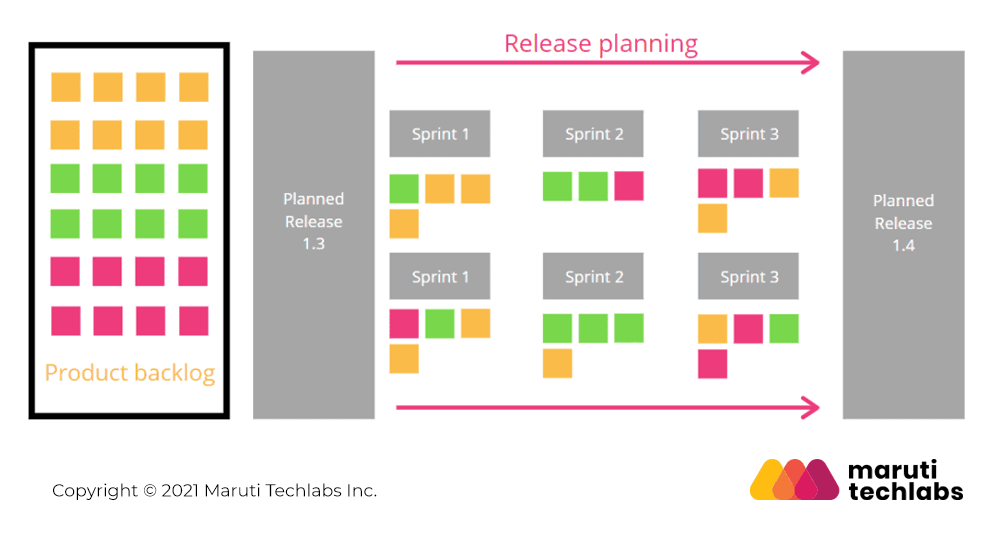
Seamlessly tying agile release plans with DevOps pipelines enables faster, automated deployments. In 2025, continuous integration and delivery are essential, reducing release risks, accelerating feedback loops, and ensuring agile teams move from planning to production without bottlenecks.
AI-powered tools in 2025 support agile release planning by predicting risks, optimizing sprint capacity, and automating reporting. Teams gain actionable insights, smarter prioritization, and real-time adaptation, improving decision-making and freeing focus for innovation and customer outcomes.
Modern agile release planning emphasizes delivering business value, not just launching features. By 2025, success metrics focus on outcomes like customer satisfaction, retention, and ROI. This shift ensures teams prioritize impact and sustainability over output volume.
The main objective of Agile release planning is to ensure that your project is leading in the right direction by following the Agile methodology. It allows you to identify whether the logical release is happening regularly and the feedback from the customer is incorporated into the release process.
At Maruti Techlabs, before embarking on any new project, we first develop a high-level overview of the software that needs to be developed. It includes assessing the technical feasibility of the software to verify its viability in today's competitive environment. The entire project is then broken down into different sprints where at the end of the sprint, we ship whatever features are completed.
The agile project plan is more detailed than the product roadmap, displaying the timeline and high-level scope of the Scrum project. However, the release plan prefers batching the iterations and sprints into the release instead of planning the detailed outline of work in each release.
Some benefits of Agile release planning are:
Agile release planning offers several benefits for Agile software development teams, including improved project visibility, increased adaptability, and enhanced customer satisfaction.
Agile release planning is a great tool that can significantly impact the user experience, as implementing Agile helps cut your time to market up to 70% for any new product.
Here are the 5 important components of agile release plan.
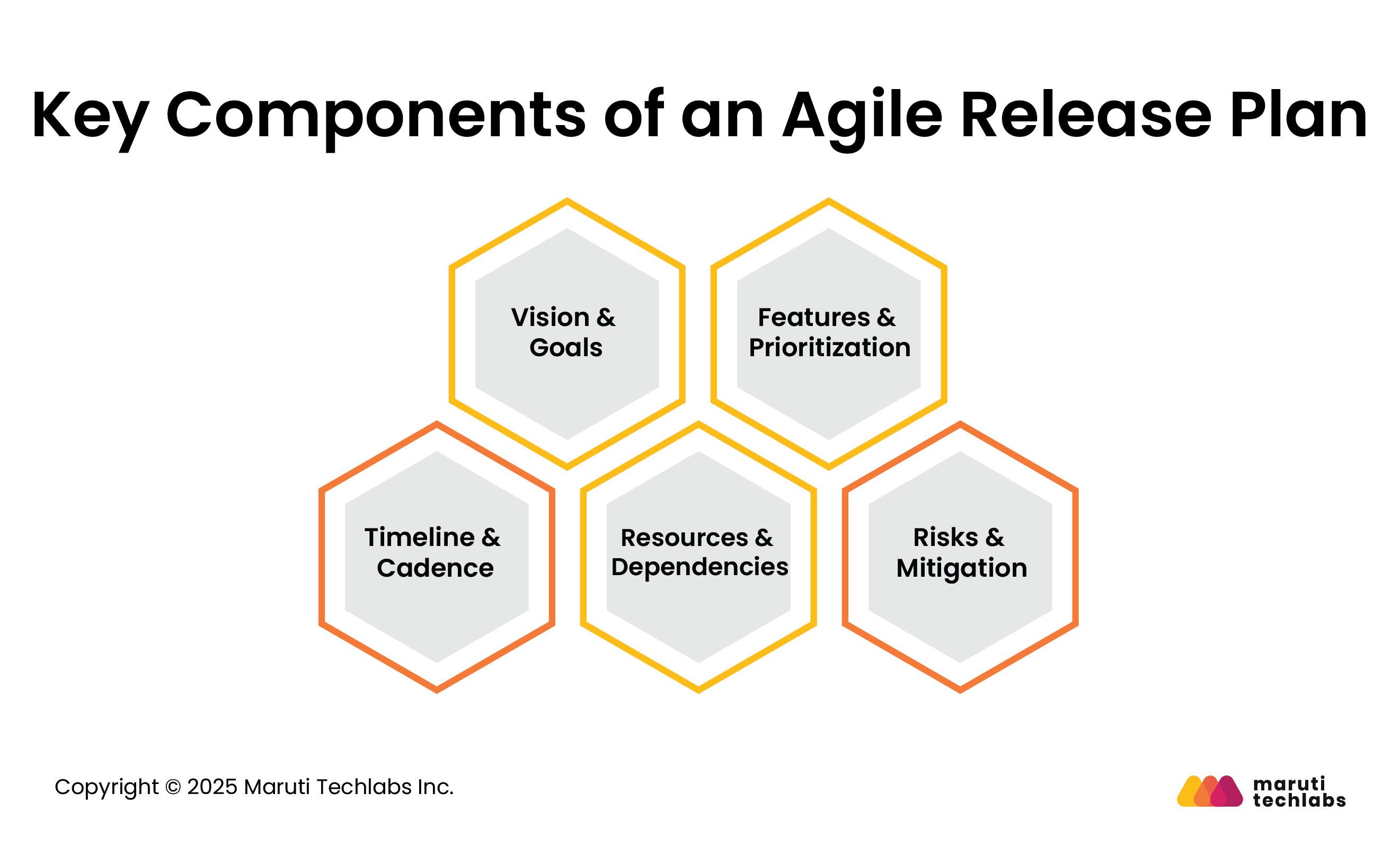
A release plan begins with a clear vision and measurable goals. This provides direction, aligns stakeholders, and ensures every iteration contributes to long-term objectives. This clarity around purpose helps teams focus efforts on delivering maximum business value.
Agile release plans define high-value features and prioritize them based on customer needs, business impact, and technical feasibility. Prioritization ensures limited resources are invested wisely, balancing quick wins with strategic capabilities for sustained growth and innovation.
Release plans establish a timeline, usually spanning 2–6 months, to maintain momentum while allowing adaptability. Setting a cadence helps teams manage scope, track progress, and adjust quickly to market or customer changes without losing direction.
Effective planning accounts for available resources, people, skills, tools and maps dependencies between teams or systems. This prevents bottlenecks, ensures smooth coordination, and helps organizations allocate capacity realistically, leading to timely, high-quality delivery across interconnected workstreams.
Identifying risks early such as delays, capacity issues, or technical challenges is crucial. Agile release plans include proactive mitigation strategies, contingency measures, and continuous monitoring. This reduces uncertainty, builds resilience, and strengthens stakeholder confidence in the delivery process.
While working with the Agile methodology, the last thing you want to do is to get confused between product roadmap and release planning. Both of these are project management tools, yet they serve quite a different purpose. They play distinct roles in the product development life cycle and have significant differences.
A product roadmap conveys a high-level overview of the product strategy. In contrast, the release plan is a document that helps track the features designed for the upcoming product release.
Looking at the project management hierarchy, the release plan always stays below the product roadmap. In Agile, the hierarchy progresses down a series of layers moving from strategic to tactical, as shown below:
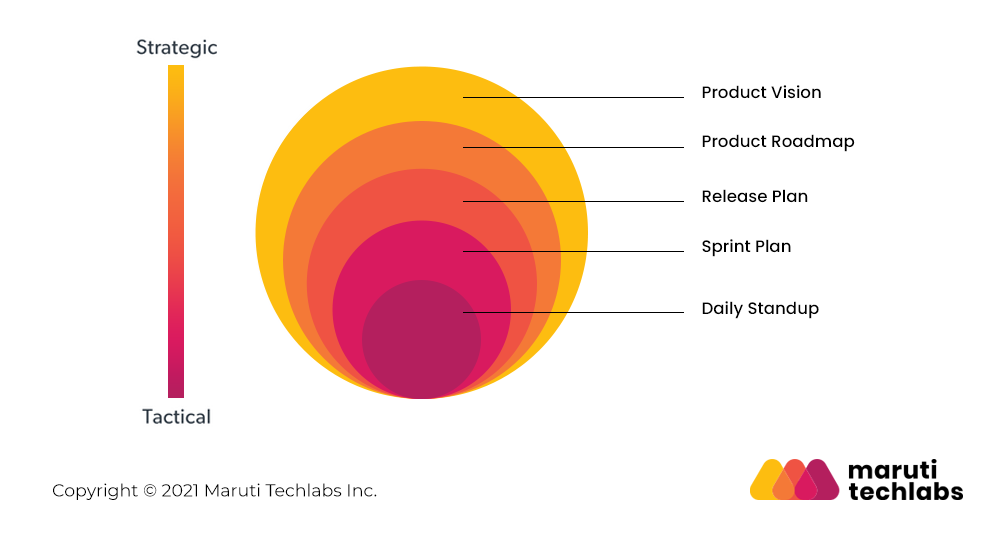
Regarding the primary differences between product roadmaps and release plans, product roadmaps serve as the long-term perspective involving multiple releases. On the other hand, release plans are short-term and more granular. They focus on the specific task to be done and contain the details for individual backlog items.
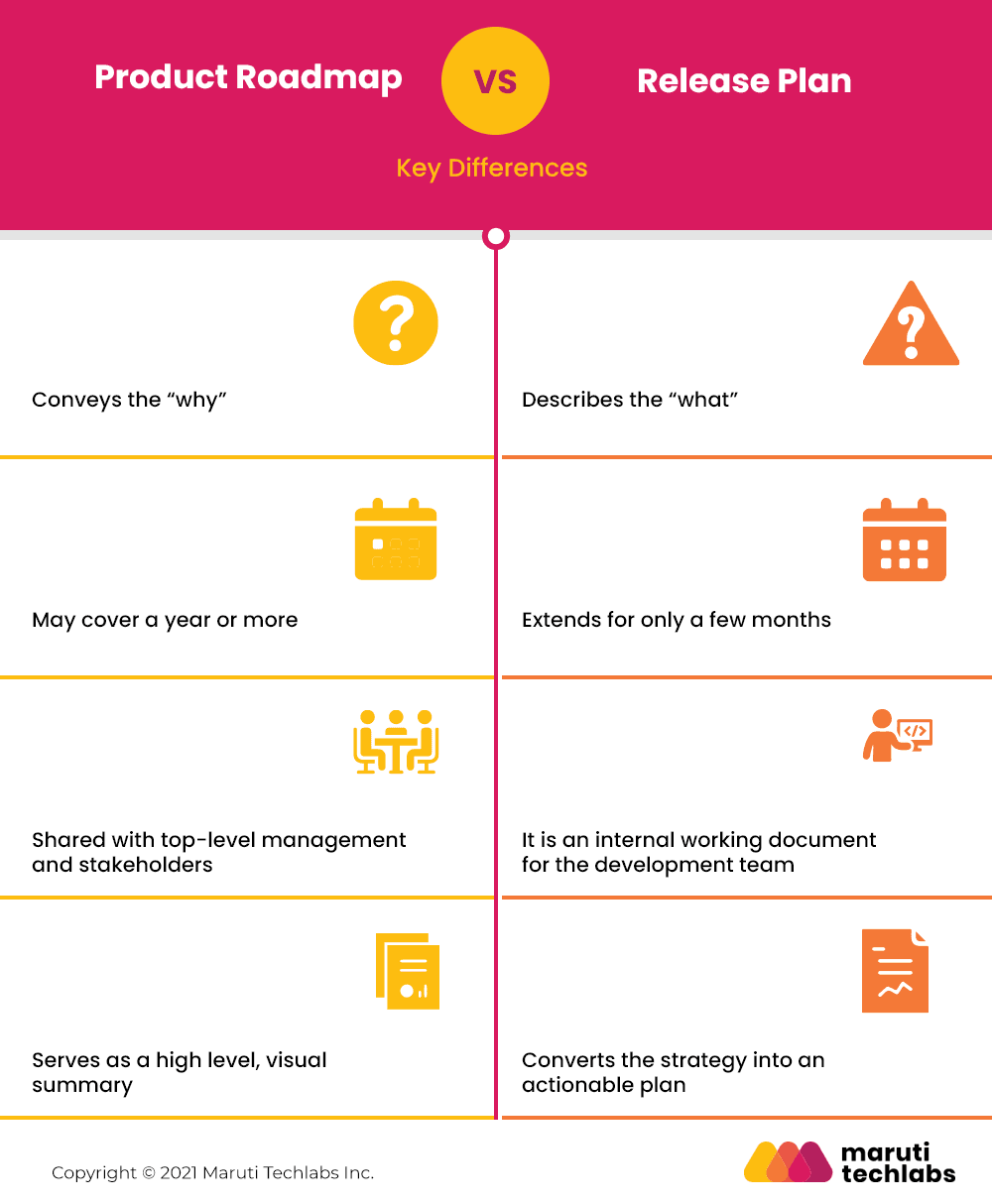
Even though product roadmap and release plan have significant differences, a project relies on both of them. Asking yourself why? Let’s find out!
Not only does the product roadmap serve as a high-level project strategy to display the objective of your project, but it also contributes as a valuable tool for many other reasons.
Product roadmap helps you compel your plan in a presentable format, including all the strategic level details such as product designs and expected goals. It is the best tool that helps you communicate with your team and explain the vision of your project throughout the product development process, ensuring that the work is executed according to plan.
Here is a glimpse of the Product Roadmap for WotNot. WotNot is a no code chatbot and live chat platform that creates intelligent, interactive and customizable bots for your startups, SMBs and enterprises across multiple channels. The chatbot comes coupled with an analytics dashboard and live chat agent console.
The team of 30+ engineers at WotNot, follow the agile release process end to end, as described in this blog.
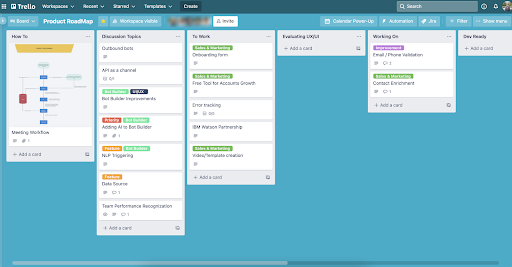 Product Roadmap of WotNot– Nocode Chatbot and Live Chat Platform
Product Roadmap of WotNot– Nocode Chatbot and Live Chat Platform
To reach the final goal, you also need to execute the tasks and features enlisted under the product roadmap. It is where the release planning comes into the picture.
The release plan enables you to execute the features of your product during every new release. In simple words, it is the small chunks of the product roadmap on which your team can effectively work on and get the final results.
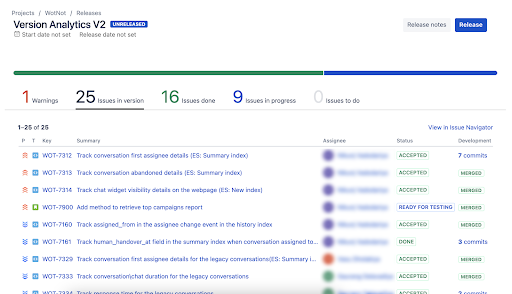 Release Plan of WotNot– No Code Chatbot and Live Chat Platform
Release Plan of WotNot– No Code Chatbot and Live Chat Platform
That’s how the product roadmap and release plan work together for developing an effective product. Over time, you will encounter the inevitable changes while developing the product, and it is essential to keep these two perspectives aligned.
The minute changes in the agile release planning will reflect the significant changes in the product roadmap, directly affecting the final product at the end. Also, the challenges at the release level, such as delay for the launch, can affect the product roadmap strategies, ultimately disturbing the final product.
Release planning comes to play after outlining your product roadmap and vision. Later, planning the release and combining it with sprints to form the significant release is often the wise choice, especially when you have many items in your product backlog.
It is often noticed that people don’t like change. It takes time for users to adopt the new interface. So batching the modifications to the UX is a must. Note that the Scrum release is not part of the Scrum Guide meeting and initial processes.
Also, many Scrum teams prefer to work without the release planning because Scrum always focuses on shorter sprint cycles for the Agile project. Instead of the release plan, they focus on product increment, speed, and fulfilling the stakeholder’s need in any particular situation.
An agile release planning process provides structure without sacrificing flexibility. It transforms high-level goals into actionable steps, ensuring teams stay aligned, risks are managed, and releases deliver maximum value while adapting to changing market and customer needs.

Start by clarifying the product vision and setting release goals. This establishes purpose, unites stakeholders, and ensures every feature planned contributes directly to business outcomes, customer value, and long-term strategy rather than fragmented, isolated deliverables.
Gather backlog items, refine them, and prioritize based on business value, urgency, and feasibility. Effective prioritization ensures resources are focused on the most impactful features, aligning delivery with customer expectations and organizational goals.
Evaluate team capacity realistically, considering skills, availability, and past velocity. Allocate work according to this capacity to prevent overload, improve predictability, and ensure commitments are achievable while supporting a sustainable development pace.
Set a release cadence, typically 2–6 months, broken into sprints. This timeline balances predictability with flexibility, enabling teams to adapt quickly while providing stakeholders visibility into progress, dependencies, and expected delivery milestones.
Anticipate risks and dependencies across teams, technologies, or external factors. Document and prioritize these issues, then create mitigation strategies. Addressing them upfront minimizes disruption, reduces uncertainty, and increases stakeholder confidence in the release plan.
Engage stakeholders early, ensuring alignment on scope, priorities, and expectations. Regular communication fosters trust, avoids misunderstandings, and helps cross-functional teams collaborate smoothly toward shared goals and outcomes throughout the release cycle.
Monitor progress with agile metrics, review feedback, and adjust plans as conditions evolve. Continuous tracking and adaptation ensure releases remain aligned with business value, enabling faster responses to change and sustainable delivery over time.
Effective release planning aligns product vision with execution, ensuring teams deliver customer value consistently. By focusing on outcomes, collaboration, and adaptability, organizations can create a structured yet flexible framework that improves delivery predictability and enhances stakeholder confidence throughout the release cycle. Here are some essential things to keep in mind.
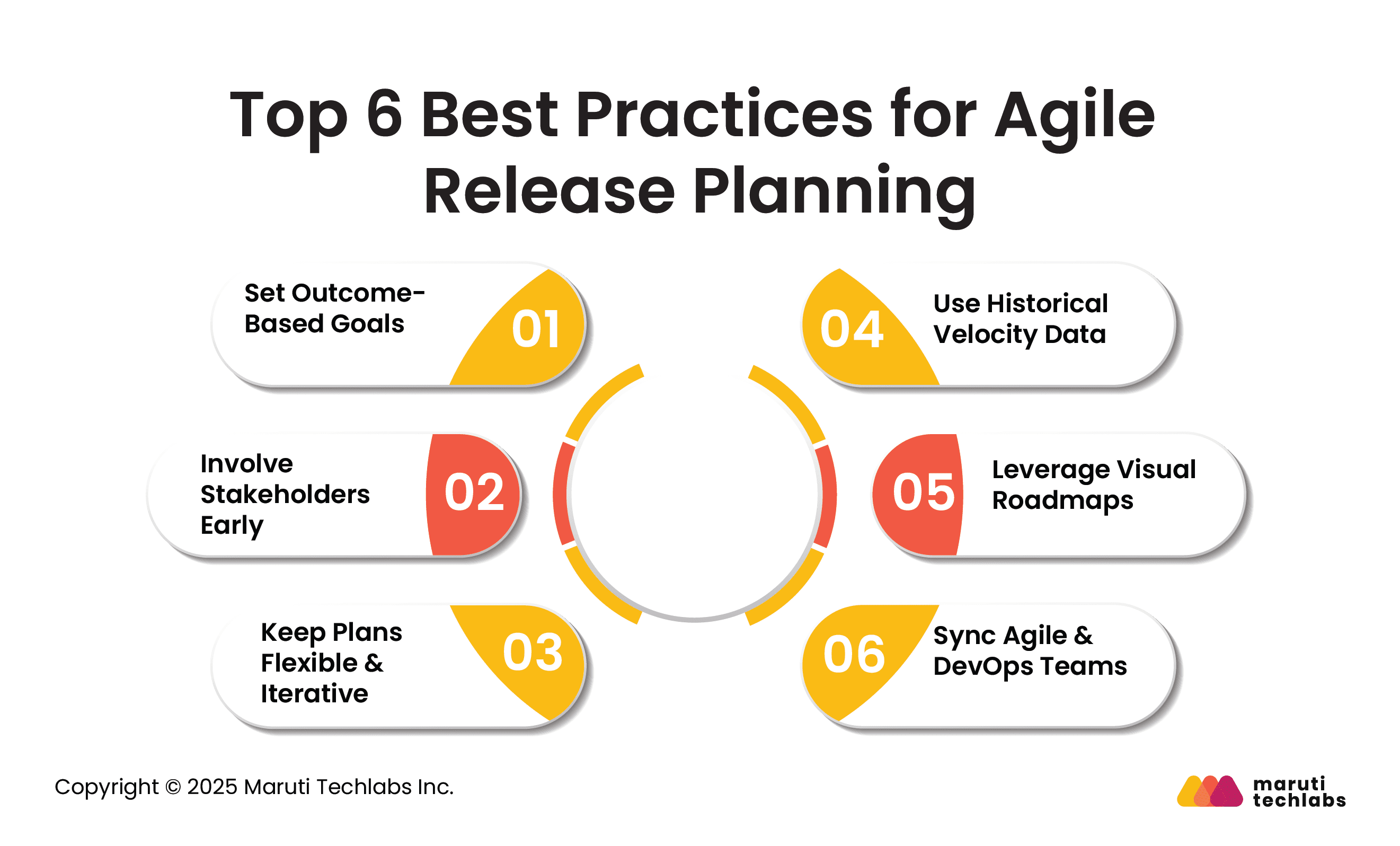
Rather than listing features, define goals in terms of measurable outcomes that deliver real customer value. Outcome-based planning shifts focus from output to impact, ensuring every release advances strategic objectives, enhances user experience, and creates tangible business benefits beyond just software delivery.
Early stakeholder involvement fosters transparency, alignment, and shared ownership. Engaging product managers, developers, operations, and business leaders from the start ensures priorities are clear, risks are surfaced, and expectations are realistic. This reduces surprises and conflicts during execution while improving collaboration and trust.
Rigid release plans often fail when conditions change. An iterative, adaptive approach ensures responsiveness to market dynamics, customer feedback, and technical challenges. Flexibility helps teams pivot without losing sight of overarching goals, driving continuous improvement, reduced risk, and higher overall delivery success.
Velocity trends provide realistic insights into team capacity and throughput. By analyzing past performance, teams can forecast delivery timelines more accurately, avoid overcommitment, and build trust with stakeholders. Data-driven planning reduces uncertainty and grounds release schedules in evidence rather than speculation.
Roadmaps offer clarity by visually connecting strategic goals, features, and timelines. They foster alignment across teams and stakeholders, simplifying communication of priorities and dependencies. A visual approach makes progress transparent, reduces ambiguity, and enables faster adjustments when business priorities or technical needs evolve.
Integrating Agile planning with DevOps practices bridges strategy and execution. Continuous integration, automated testing, and deployment pipelines ensure faster, more reliable releases. This alignment reduces bottlenecks, accelerates feedback, and improves overall software quality, making the release process seamless, predictable, and customer-centric.
Agile release planning tools empower teams to align priorities, track progress, and manage dependencies with greater transparency and efficiency, ensuring every release delivers meaningful customer value while maintaining flexibility in execution.
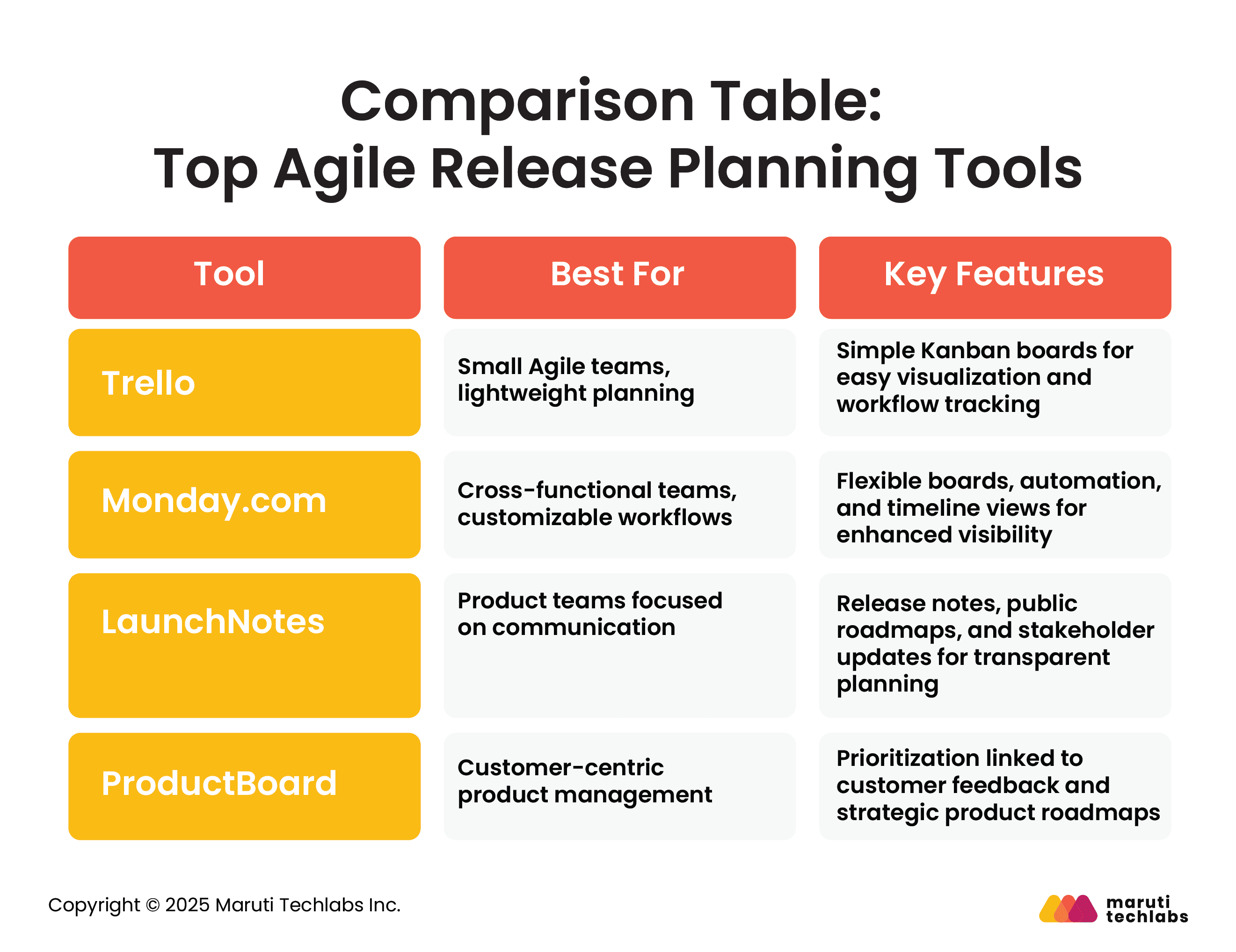
Jira is a widely adopted Agile project management tool offering robust backlog management, sprint planning, and release tracking features. Its customizable workflows, reporting dashboards, and integration ecosystem make it ideal for teams managing complex projects with multiple dependencies across distributed environments.
Azure DevOps provides a comprehensive platform for Agile planning, CI/CD, and release management. It integrates code repositories, pipelines, and boards, enabling seamless collaboration between developers and operations. Its built-in scalability makes it particularly suitable for enterprise-level release planning and execution.
Trello uses an intuitive Kanban board approach for release planning, helping teams organize tasks, track progress, and visualize workflows. Its simplicity, flexibility, and wide integration options make it ideal for smaller Agile teams seeking lightweight, easy-to-adopt planning solutions.
Monday.com offers a versatile work management platform with customizable boards, timelines, and dashboards. For release planning, it enables teams to align sprints, manage dependencies, and track deliverables while providing high visibility, automation features, and strong collaboration tools for cross-functional teams.
LaunchNotes specializes in release communication and stakeholder alignment. It allows teams to announce updates, share roadmaps, and gather feedback, ensuring transparency across product releases. Its focus on engagement helps product managers keep customers, teams, and executives consistently informed and aligned.
ProductBoard is a product management tool designed to connect customer feedback with release planning. It enables teams to prioritize features, map roadmaps to strategic goals, and communicate upcoming releases. Aligning development with customer needs ensures more impactful, outcome-driven releases.
Tool | Best For | Key Features | |
| Trello | Small Agile teams, lightweight planning |
| |
| Monday.com | Cross-functional teams, customizable workflows | Flexible boards, automation, and timeline views for enhanced visibility | |
| LaunchNotes | Product teams focused on communication | Release notes, public roadmaps, and stakeholder updates for transparent planning | |
| ProductBoard | Customer-centric product management | Prioritization linked to customer feedback and strategic product roadmaps |
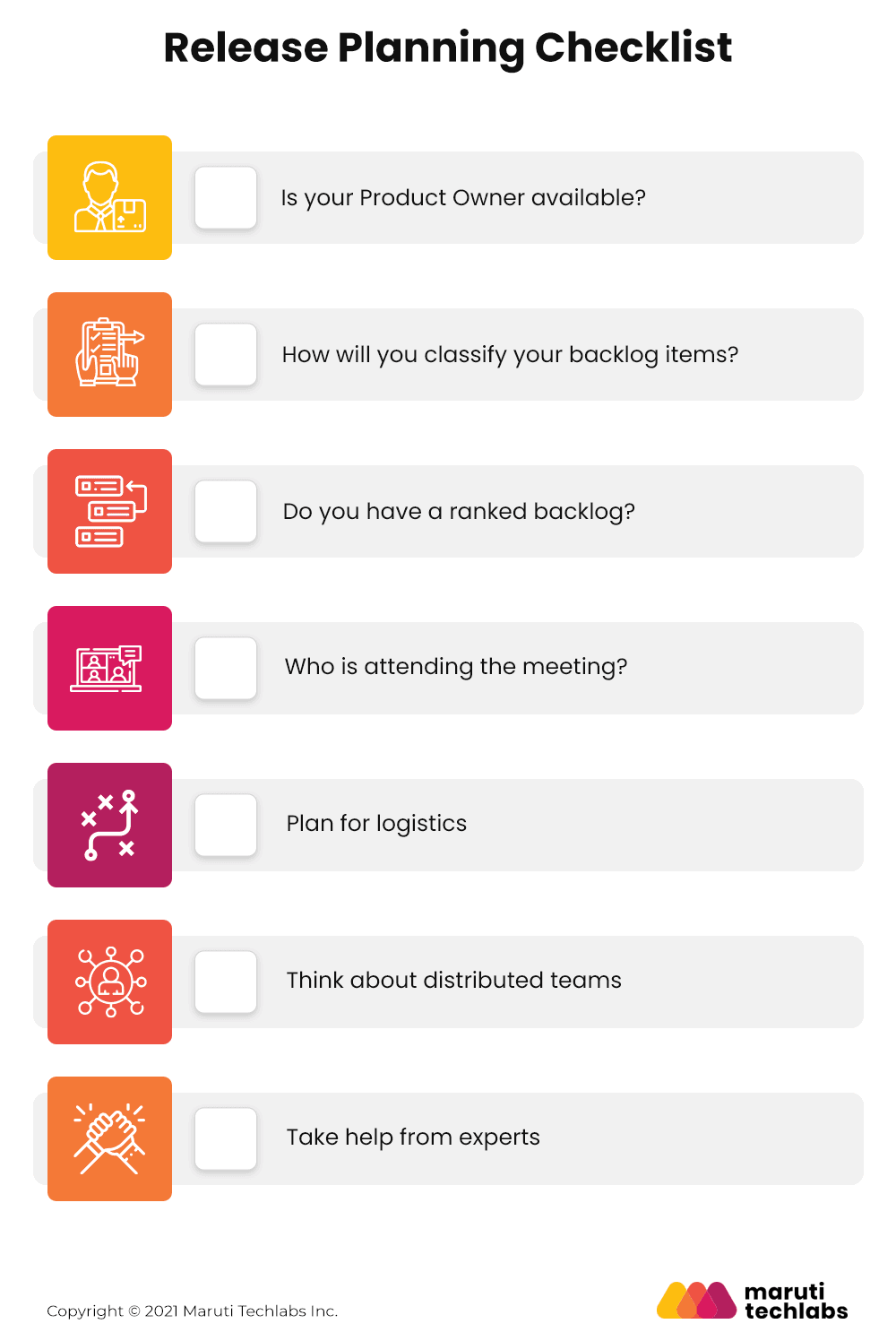
Keep in mind the following questions and define their answers for your next Agile release plan.
Before developing and executing your agile release planning, ensure the decision-maker of your project is available, whether it be product owner or analyst, etc.
Gather a large group of individuals who can help you to size some backlog items for your project. It is wise to define a single baseline for sizing your items.
Ask the product manager to prioritize your product’s high-level features, which the product owner hopes to have in the upcoming release.
Everyone responsible for the release plan needs to attend the meeting to help develop the plan and commit to the release for achieving the product vision.
Plan your schedule. Define your goals and get them reviewed by the Scrum master and stakeholders. Provide food and drinks along with flip charts and breakout rooms to have timely breaks from the workspace.
Keep in touch with distributed team members frequently via digital platforms. Avoid discrimination between offline teams and remote teams.
Ask for help from experienced facilitators and professionals to guide you through your project and agile release planning. Don’t be afraid to ask for help.
Did you find the video snippet on How to ensure operational efficiency in agile? to be insightful? We have a ~22 min video where Mitul Makadia gets into the weeds, and we discuss about Implementing & Scaling Agile to streamline Software Development. Take a look –
Agile release planning is the key to the successful completion and delivery of end products. Eventually, release planning provides the solution for every risk you face during the development process. It helps you present the final product to your stakeholders just like they expected without disturbing your existing customers. That’s why Agile release planning is always a crucial aspect of software development. It is the first step to the successful completion of the project.
Also Read: 8-Step Guide To New Product Development Process (NPD)
We hope you can better assist your team in planning a successful release for your product deployment with the help of this comprehensive guide. By following the steps in this guide, you can ensure that the next release of your software is as successful as possible.
At Maruti Techlabs, we build and deploy products in no time with the help of our rapid prototyping services. This enables our clients to quickly test and validate their ideas as we work with them on defining product-market fit via the lean startup approach. Given our 12+ years of experience in building and scaling digital products, we know a thing or two about planning, designing, developing, and deploying successful software and services, using the right mixture of agile framework and modern tech stack.
Our main motto is to innovate and deliver exceptional products to our clients and create value for their customers. We focus on standardizing your software development process by understanding your requirements and business needs.
Given our experience in the field of Agile development, our Product Development Services will help you communicate ideas and provide you with a chance to innovate your product with precision.
Connect with our team for a free consultation and we’ll take it from there.
Agile release planning is a way to map out what features or improvements a team will deliver in upcoming releases. Instead of fixed long-term plans, it focuses on short, iterative cycles, aligning business goals with customer needs while remaining flexible to change.
Release planning is usually done every few months, often aligned with a program increment or quarterly cycle. Teams revisit and update plans regularly, adjusting based on progress, feedback, and market changes to stay relevant, achievable, and aligned with business priorities.
Traditional release planning relies on rigid, upfront scheduling and detailed scope, often fixed for months or years. Agile release planning emphasizes adaptability, shorter planning horizons, continuous feedback, and iterative delivery. This approach reduces risks, supports faster value delivery, and ensures alignment with evolving customer needs.
Popular Agile release planning tools include Jira for advanced backlog and sprint management, Azure DevOps for integrated development and operations, Trello or Monday.com for visual lightweight planning, and LaunchNotes or ProductBoard for customer-focused communication and roadmap alignment across teams and stakeholders.


